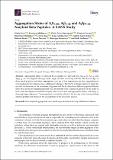Aggregation states of Aβ1-40, Aβ1-42 and Aβp3-42 amyloid beta peptides: a SANS study
Author(s)
Festa, Giulia; Mallamace, Francesco; Sancesario, Giulia Maria; Corsaro, Carmelo; Mallamace, Domenico; Fazio, Enza; Arcidiacono, Laura; Garcia Sakai, Victoria; Senesi, Roberto; Preziosi, Enrico; Sancesario, Giuseppe; Andreani, Carla; ... Show more Show less
Downloadijms-20-04126.pdf (1.191Mb)
Publisher with Creative Commons License
Publisher with Creative Commons License
Creative Commons Attribution
Alternative title
Aggregation states of Aβ[subscript 1-40], Aβ[subscript 1-42] and Aβp[subscript 3-42] amyloid beta peptides: a SANS study
Terms of use
Metadata
Show full item recordAbstract
Aggregation states of amyloid beta peptides for amyloid beta A β[subscript 1-40] to A β[subscript 1-42] and A βp[subscript 3-42] are investigated through small angle neutron scattering (SANS). The knowledge of these small peptides and their aggregation state are of key importance for the comprehension of neurodegenerative diseases (e.g., Alzheimer’s disease). The SANS technique allows to study the size and fractal nature of the monomers, oligomers and fibrils of the three different peptides. Results show that all the investigated peptides have monomers with a radius of gyration of the order of 10 Å, while the oligomers and fibrils display differences in size and aggregation ability, with A βp[subscript 3-42] showing larger oligomers. These properties are strictly related to the toxicity of the corresponding amyloid peptide and indeed to the development of the associated disease. Keywords: beta amyloid; aggregation state; small angle neutron scattering; Alzheimer’s disease
Date issued
2019-08-24Department
Massachusetts Institute of Technology. Department of Nuclear Science and EngineeringJournal
International Journal of Molecular Sciences
Publisher
Multidisciplinary Digital Publishing Institute
Citation
Festa, Giulia, et al., "Aggregation states of Aβ1-40, Aβ1-42 and Aβp3-42 amyloid beta peptides: a SANS study." International Journal of Molecular Sciences 20, 17 (2019): no. 4126 doi 10.3390/ijms20174126 ©2019 Author(s)
Version: Final published version
ISSN
1422-0067